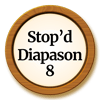A few of the organs I’ve played
We were lucky to play a number of exceptional Baroque organs including:-
Oude Kerk, Amsterdam
 “The huge baroque organ of Oude Kerk in Amsterdam is known for its unique sound and while the church has also two other more modern organs, it is often called the Grand Organ of the church. It was built between 1724-1726 by a German Christian Vater from Hanover. The Oude Kerk Grand Organ has 54 gold plated oak pipes.
“The huge baroque organ of Oude Kerk in Amsterdam is known for its unique sound and while the church has also two other more modern organs, it is often called the Grand Organ of the church. It was built between 1724-1726 by a German Christian Vater from Hanover. The Oude Kerk Grand Organ has 54 gold plated oak pipes.
The Grand Organ is called the Vater-Müller Organ, thus giving credit to both of its builders. In 1869-1870 the organ was once again revised and retuned by Christian Gottlieb Friedrich Witte.”
Alkmaar
 “The organ at the west end of the church is one of the most famous, significant and beautiful organs in the world. It was built by Jacobus Caltus van Hagerbeer, finished in 1645. The organ was rebuilt in 1723 by Frans Caspar Schnitger. He left the casework much as it was, but created an organ in the North German style within the old case. He reused much of the old fluework, but all the mixtures and reeds were new. The organ has not been changed much since then, and is rare in that 90 percent of the original material, pipework, action, soundboards, case, survives.”
“The organ at the west end of the church is one of the most famous, significant and beautiful organs in the world. It was built by Jacobus Caltus van Hagerbeer, finished in 1645. The organ was rebuilt in 1723 by Frans Caspar Schnitger. He left the casework much as it was, but created an organ in the North German style within the old case. He reused much of the old fluework, but all the mixtures and reeds were new. The organ has not been changed much since then, and is rare in that 90 percent of the original material, pipework, action, soundboards, case, survives.”St Bavo, Haarlem
 “The organ of the Sint-Bavokerk (the Christiaan Müller organ) is one of the world’s most historically important organs. It was built by the Amsterdam organ builder Christian Müller, with stucco decorations by the Amsterdam artist Jan van Logteren, between 1735 and 1738. Upon completion it was the largest organ in the world with 60 voices and 32-foot pedal-towers. Many famous musicians played this organ, including Mendelssohn, Händel and the 10-year-old Mozart, who played it in 1766, (and me!).”
“The organ of the Sint-Bavokerk (the Christiaan Müller organ) is one of the world’s most historically important organs. It was built by the Amsterdam organ builder Christian Müller, with stucco decorations by the Amsterdam artist Jan van Logteren, between 1735 and 1738. Upon completion it was the largest organ in the world with 60 voices and 32-foot pedal-towers. Many famous musicians played this organ, including Mendelssohn, Händel and the 10-year-old Mozart, who played it in 1766, (and me!).”Whist on a visit to Yorkshire I was able to play 2 very fine English organs. One following the great Cathedral style and the other in a Town Hall, with all the “drums and whistles”.
Beverley Minster
 “The first organ was built by Snetzler in 1767 and many of the original pipes are incorporated within the present instrument which has undergone many changes. At its opening in 1769 the modern music of Handel was performed. The most recent refurbishment took place in the 1990s and was dedicated in 1995. There are nearly 4000 pipes, four manuals and pedal board. There are 72 stops providing combinations of sound that suit a large repertoire of music from different styles and countries.”
“The first organ was built by Snetzler in 1767 and many of the original pipes are incorporated within the present instrument which has undergone many changes. At its opening in 1769 the modern music of Handel was performed. The most recent refurbishment took place in the 1990s and was dedicated in 1995. There are nearly 4000 pipes, four manuals and pedal board. There are 72 stops providing combinations of sound that suit a large repertoire of music from different styles and countries.”Hull, City Hall
 “The City Hall organ was built by the Hull firm of Forster and Andrews for a cost of £4,328 and completed in March 1911 ready for the opening recital by Edwin Lamare on Thursday 30 March 1911. Philip H Selfe planned and designed the organ for Hull City Hall including the outstanding organ case.”
“The City Hall organ was built by the Hull firm of Forster and Andrews for a cost of £4,328 and completed in March 1911 ready for the opening recital by Edwin Lamare on Thursday 30 March 1911. Philip H Selfe planned and designed the organ for Hull City Hall including the outstanding organ case.”
“During the war, Hull was subjected to intense aerial bombardment and the City Hall roof was extensively damaged resulting in the closure of the building in May 1941. The Hall was reopened in 1950, followed a year later by the completion of the restoration and enhancement. The rebuild was entrusted to the John Compton Organ Company.”
The organ was rebuilt again in the late 1980s, after I had played it.
As Harrison (Fred) Oxley was my teacher and Master of Music at St Edmundsbury Cathedral, I played this one as well

